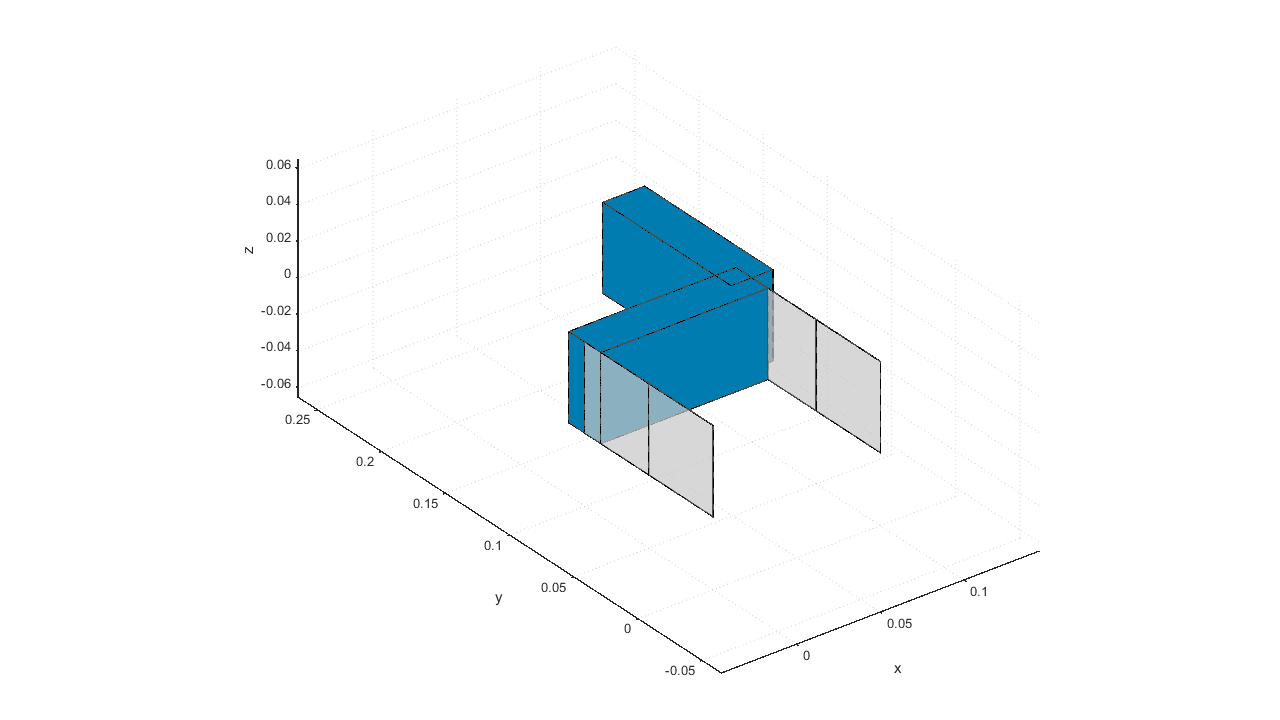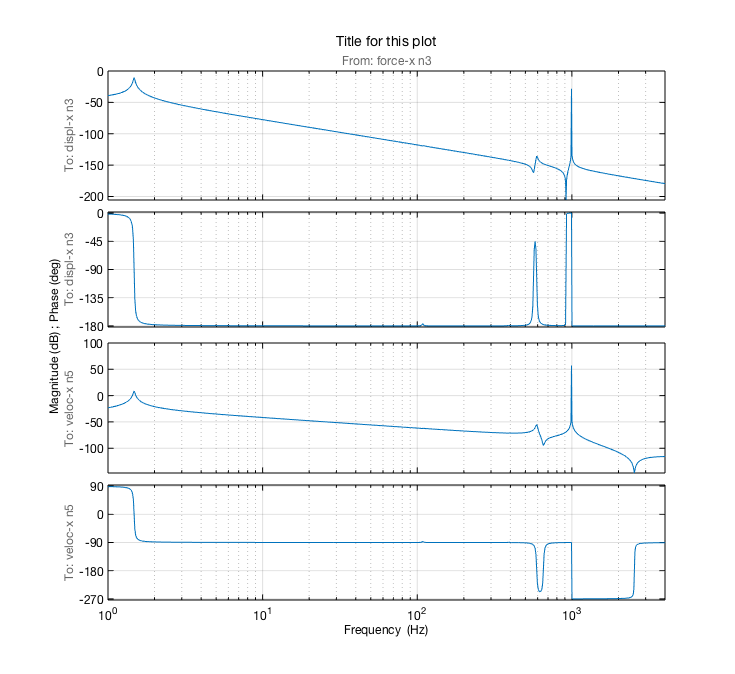SPACAR Light
Example: Compute transfer function of a parallel flexure guide
This example shows the computation of the transfer function from input actuator force (force in x-direction on the end-effector) to output stage displacement and velocity (motion in x-direction of the end-effector) of a parallel flexure guide.

The state-space equations (from which the transfer function follows) can be computed by specifying the input and output for the transfer function. For this example, actuation force in x-direction on node 3 (a node on the end-effector) is used for input. Two desired outputs are specified: the first is the displacement in x-direction of node 3; the second is the velocity in x-direction of node 5. These can be specified with the nprops(i).transfer_in and nprops(i).transfer_out arguments. Furthermore, to enable the computation of the state-space equations, the optional field opt.transfer has to be set to true. For details, see the SPACAR Light full syntax. For this case, the MATLAB file that defines the flexure mechanism is supplemented with
nprops(3).transfer_in = {'force_x'}; %Input 1 for state-space equations nprops(3).transfer_out = {'displ_x'}; %Output 1 for state-space equations nprops(5).transfer_out = {'veloc_x'}; %Output 2 for state-space equations ... opt.transfer = {true 0.01}; %Calculation of state-space equations (with relative damping 0.01)
Note that
- the state-space equations can only be computed for an undeformed flexure mechanism. Therefore, no external loads (actuation force) or input displacements are allowed when computing state-space equations. (An error message will appear.)
- velocity outputs are supported as well;
- relative damping for all modes of the system can be specified optionally by means of the
opt.transferfield.
For details, see the SPACAR Light full syntax.
The resulting transfer function between the input and the first output is plotted in the figure below. The first eigenfrequency is approximately 10 rad/s; the first parasitic eigenfrequency appears at 360 rad/s.
Note that in case of multiple inputs and/or outputs, the resulting state-space structure in MATLAB will also indicate with named labels what these inputs and outputs are (i.e. node number and displacement, velocity or force).
An example file for providing the input for SPACAR Light and plotting the transfer function is provided below.
- example.m
% EXAMPLE SCRIPT FOR RUNNING SPACAR LIGHT % This example simulates a parallel flexure guide and computes the transfer % function from actuator force to sensor displacement clear clc %% NODE POSITIONS % x y z nodes = [ 0 0 0; %node 1 0 0.1 0; %node 2 0.1 0.1 0; %node 3 0.1 0 0; %node 4 0.1 0.2 0]; %node 5 %% ELEMENT CONNECTIVITY % p q elements = [ 1 2; %element 1 2 3; %element 2 3 4; %element 3 3 5]; %element 4 %% NODE PROPERTIES %node 1 nprops(1).fix = true; %Fix node 1 %node 3 nprops(3).transfer_in = {'force_x'}; %Input for state-space equations nprops(3).transfer_out = {'displ_x'}; %Output nr 1 (displ. in x-direction on node 3) for state-space equations nprops(5).transfer_out = {'veloc_x'}; %Output nr 2 (veloc. in x-direction on node 5) for state-space equations %node 4 nprops(4).fix = true; %Fix node 4 %% ELEMENT PROPERTIES %Property set 1 eprops(1).elems = [1 3]; %Add this set of properties to elements 1 and 3 eprops(1).emod = 210e9; %E-modulus [Pa] eprops(1).smod = 70e9; %Shear modulus [Pa] eprops(1).dens = 7800; %Density [kg/m^3] eprops(1).cshape = 'rect'; %Rectangular cross-section eprops(1).dim = [50e-3 0.2e-3]; %Width: 50 mm, thickness: 0.2 mm eprops(1).orien = [0 0 1]; %Orientation of the cross-section as a vector pointing along "width-direction" eprops(1).nbeams = 2; %2 beam elements for simulating these flexures eprops(1).flex = 1:6; %Fully flexible beam eprops(1).color = 'grey'; %Color of elements eprops(1).opacity = 0.7; %Opacity of elements % eprops(1).warping = true; %Enable modeling of warping, e.g. for the effect of constrained warping %Property set 2 eprops(2).elems = [2 4]; %Add this set of properties to element 2 and 4 eprops(2).dens = 7800; %Density [kg/m^3] eprops(2).cshape = 'rect'; %Rectangular cross-section eprops(2).dim = [50e-3 25e-3]; %Width: 50 mm, thickness: 25 mm eprops(2).orien = [0 0 1]; %Orientation of the cross-section as a vector pointing along "width-direction" eprops(2).nbeams = 1; %1 beam element for simulating this component eprops(2).color = 'darkblue'; %Color of elements %% OPTIONAL ARGUMENTS opt.transfer = {true 0.01}; %Calculation of state-space equations (with relative damping 0.01) opt.filename = 'file'; %Names of files that are produced %% CALL SPACAR_LIGHT out = spacarlight(nodes, elements, nprops, eprops, opt); %% Plot transfer function %set some convenient defaults for the plot. Not necessary, but they can improve the plots bodeopt = bodeoptions; bodeopt.Title.String = 'Title for this plot'; bodeopt.FreqUnits = 'Hz'; %default frequency units bodeopt.Xlim = [1,4000]; %frequency axis limits bodeopt.Grid = 'on'; %show a grid bodeopt.Title.FontSize = 14; %font size for title bodeopt.XLabel.FontSize = 12; %font size for xlabels bodeopt.YLabel.FontSize = 12; %font size for ylabels bodeopt.TickLabel.FontSize = 12; %font size for the ticks (numbers on axes) bodeopt.InputLabels.FontSize = 12; bodeopt.OutputLabels.FontSize = 12; bodeopt.PhaseMatching = 'on'; %phase matching: adding multiples of 360 so that: bodeopt.PhaseMatchingFreq = 1; %--at this frequency bodeopt.PhaseMatchingValue = 0; %--the phase is close to this value h = bodeplot(out.statespace,bodeopt); %make the plot

